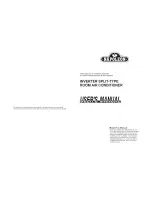
5
5
- 19
W-2WAY ECO-i SYSTEM
Trouble Diagnosis
4. W-2WAY ECO-i Alarm Codes
H06 Alarm
Alarm code
H06
Alarm meaning
Low-pressure switch activated
Alarm conditions
A report occurs during A/C operation when the low-pressure sensor installed at constant
low-pressure parts detects a pressure of 0.05 MPa or less continuously for 2 minutes,
or an instantaneous pressure of 0.02 MPa or less. (These values represent abnormal low
pressure which may damage the compressor.)
However, the alarm does not actually occur the fi rst 2 times that the above operation takes place.
At these times, the outdoor unit is stopped and the conditions are monitored. The alarm occurs
when the above operation occurs for the fi fth time. The fi rst 4 times before the alarm occurs are
called “pre-trip.” After pre-trip occurs, if the low-pressure sensor detects a pressure of 0.15 MPa
or more for 3 minutes of continuous operation, the pre-trip count is reset to 0.
If the low-pressure sensor detects a pressure of 0.16 MPa or less continuously for 30 minutes
when the compressor is stopped, an alarm occurs immediately (no pre-trip).
Probable cause
The A/C unit low pressure has dropped to a level that does not occur under ordinary conditions.
(1) The absolute amount of gas in the system is too low (as a result of insuffi cient refrigerant
charge or leak).
(2) The refrigerant has accumulated in the circuit and has not returned to the compressor.
Refrigerant has accumulated in a location of one-way fl ow and cannot escape.
High-pressure level is low, resulting in poor fl ow of refrigerant in the circuit. (A lower high-
pressure level results in a smaller difference between low pressure and high pressure, that
may be insuffi cient to cause refrigerant fl ow.)
(3) The refrigerant circuit has become closed, and refrigerant has not returned to the
compressor. In some cases when moisture enters the refrigerant circuit, it can freeze at the
low-pressure locations and the resulting ice can block the circuit.
If the alarm occurs when there is suffi cient refrigerant in the system ((1) and (3)), liquid
refrigerant has defi nitely accumulated somewhere in the system. Liquid refrigerant generally
accumulates in high-pressure locations. In this case the high pressure gradually increases
(however it may not increase if the location where the liquid accumulates is suffi ciently
large). Depending on the refrigerant saturation temperature, it may also accumulate in low
pressure locations. In this case the high pressure is unlikely to increase.
Check
(1) Check that the service valve is open.
(2) Check that none of the valves (solenoid valves, mechanical valves) in the main refrigerant
circuit is closed due to an operation failure.
(3) Check that there is no possibility of foreign objects or water having entered the refrigerant
circuit.
(4) Check that valve leakage at a stopped sub unit has not resulted in accumulation of
refrigerant at that sub unit.
(5) Check that no refrigerant leakage has occurred.
Correction
(1) If there was a valve operation failure, in general it is necessary to replace the valve.
(2) If a foreign object or moisture has entered the circuit, install a strainer or dry core (depending
on the degree of the problem).
(3) If refrigerant has leaked into stopped sub units, it is likely that valve leakage has occurred.
The valve must be replaced.
Example
Notes
W-2WAY ECO-i SYSTEM̲Eng5.indd 19
W-2WAY ECO-i SYSTEM̲Eng5.indd 19
2008/09/04 16:39:12
2008/09/04 16:39:12













































